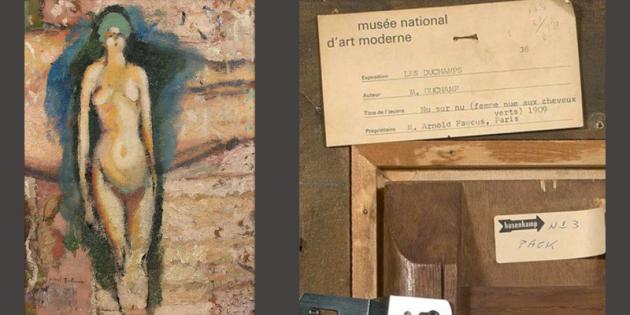The Impressionist and Modern art sale at Artcurial in Paris is offering the seminal oil painting on panel, Nu sur nu by Marcel Duchamp. The painting carries an estimate of £400,000-£550,000 (500 000 – 700 000 € / $555 000 – 775 000 ). The work, offered by N.G.O. Médecins sans frontières in order to finance humanitarian aid, was previously left to the association by ancestors of the renowned art publisher Arnold Fawcus, a close friend of Marcel Duchamp. The painting is key to understanding Marcel Duchamp’s work and was recently shown at the Centre Pompidou at the monographic exhibition dedicated to the painter in 2014.
“The piece Nu sur nu represents an important step in the evolution of Marcel Duchamp’s work. It was painted just months before the famous Nu descendant l’escalier (1912), a cubic work which was celebrated at the Armory Show in New York the following year. At this time, he moved away from fauvism and was influence by symbolism. Being classed as a national treasure is an additional mark of quality for this painting which is already quite remarkable due to its provenance. » explains Bruno Jaubert, Director of the Impressionist and Modern art department at Artcurial.
“Between 1906 and 1910 or 1911, I floated between different ideas such as fauve, cube and even coming back to some more classical things.” explains Marcel Duchamp. He began working on Nu sur nu during the winter of 1910-1911 just after leaving Montmartre to move to the Parisian suburbs near Puteaux where his brother Jacques Villon lived. The Puteaux group model, Jeanne Serre, was his lover and after posing for the enigmatic work Deux nus, she left him. At the time, Duchamp was unaware that his lover was pregnant with the child he would never have. It was during this period that Marcel Duchamp sought to evolve his artistic style. He was on a quest for a new dimension and started looking into Symbolism, attracted by the fantastic stories, the representation of the body and the painting style which expressed ideas by Odilon Redon.
The Nu sur nu was constructed around two major ideas : appearance and nudity which are also present in the cubist Nu descendant l’escalier (1912). One discovers the naked body of a woman standing up with her arms hanging by her side and crossing her legs. The lady appears to be coming out of a bluish halo of light and her hair has a green crown (this is why the piece was initially called Femme aux Cheveux Verts, Lady with the Green Hair). This composition is similar to that of the L’homme rouge (1905) by Odilon Redon. Horizontally, in the background, two female legs can be seen. The different levels of the painting and the silhouette emerging from a female mould, evokes themes of childhood and feminine mystery.
The public has been able to see the work on several occasions. It has been part of the most important retrospectives of the artist including : ‘The almost complete works of Marcel Duchamp’ at the Tate Gallery in London in 1966, ‘Marcel Duchamp’ at the MoMA in New York and at the Art Institute in Chicago in 1973-1974, ‘L’œuvre de Marcel Duchamp’ at the Musée national d’Art Moderne de Paris in 1977 and most recently ‘Marcel Duchamp : la peinture, même’ at the Centre Pompidou in 2014-2015. The painting was classed as a national treasure by the French state in 2016.
The last owner of this work was Arnold Fawcus. He was born in India to an English father and American mother. He studied at Trinity College and then Cambridge where he carried out a degree in art history. His passion for art pushed him to create a publishing company in France in 1946 with Pierre Bordas initially and then alone under the name, ‘Trianon Press’. The first publications include works by Marc Chagall accurately reproduced. It was in France that Arnold Fawcus met Marcel Duchamp. They soon became friends and the art book editor suggested collaborating on several projects including the first monograph dedicated to the artist published in 1959. They continued to work together on several occasions. The painting Nu sur nu is the symbol of their friendship. It was acquired directly from the wife of collector, Henri-Pierre Roche’s by Arnold Fawcus who kept it until he passed away. Arnold Fawcus’ ancestors donated the painting to Médecins sans frontières.
Sale Date : Monday 6th June 2016 at 8pm Exhibition Date : From Friday 3rd June 2016 To Sunday 5th June 2016 Artcurial 7, Rond-Point des Champs-Elysées 75008 Paris

